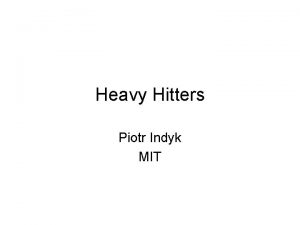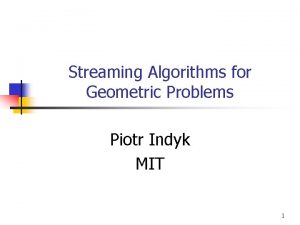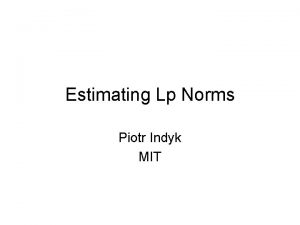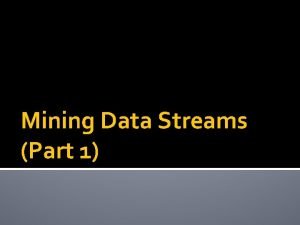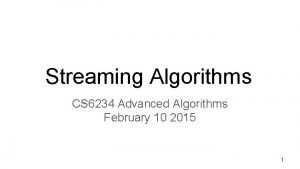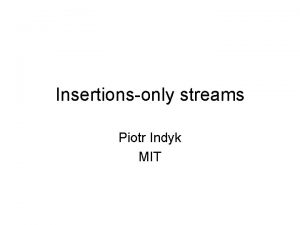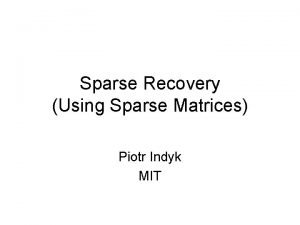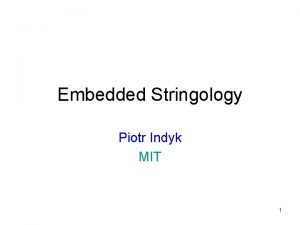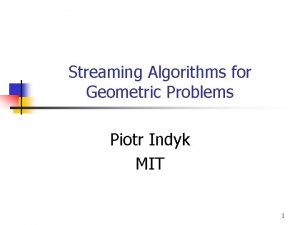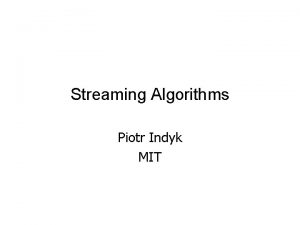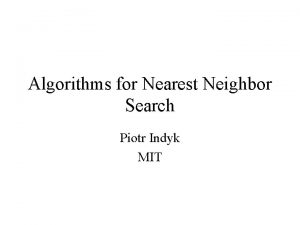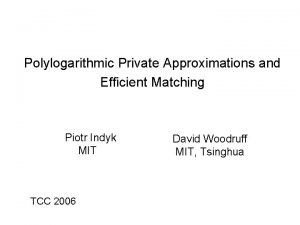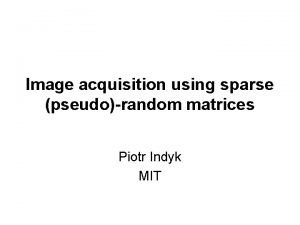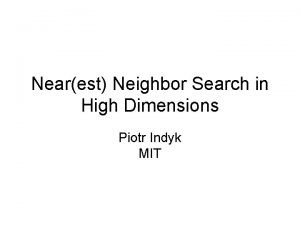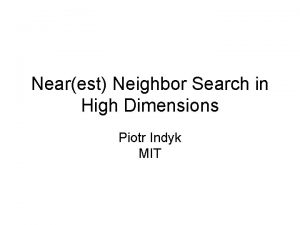Heavy Hitters Piotr Indyk MIT Last Few Lectures










![Analysis • Facts: – x*i ≥ xi – E[ xi* - xi ] = Analysis • Facts: – x*i ≥ xi – E[ xi* - xi ] =](https://slidetodoc.com/presentation_image_h/7841acf9fc6ffd9e243232f32eefc87a/image-11.jpg)





- Slides: 16

Heavy Hitters Piotr Indyk MIT

Last Few Lectures • Recap (last few lectures) – Update a vector x – Maintain a linear sketch – Can compute Lp norm of x (in zillion different ways) • Questions: – Can we do anything else ? ? – Can we do something about linear space bound for L ? ?

Heavy Hitters • Also called frequent elements and elephants • Define HHpφ (x) = { i: |xi| ≥ φ ||x||p } • Lp Heavy Hitter Problem: – Parameters: φ and φ’ (often φ’ = φ-ε) – Goal: return a set S of coordinates s. t. • S contains HHpφ (x) • S is included in HHpφ’ (x) • Lp Point Query Problem: – Parameter: – Goal: at the end of the stream, given i, report x*i=xi ||x||p

Which norm is better ? • Since ||x||1 ≥ ||x||2 ≥ … ≥ ||x|| , we get that the higher Lp norms are better • For example, for Zipfian distributions xi=1/iβ, we have – ||x||2 : constant for β>1/2 – ||x||1 : constant only for β>1 • However, estimating higher Lp norms tends to require higher dependence on

A Few Facts • Fact 1: The size of HHpφ (x) is at most 1/φ • Fact 2: Given an algorithm for the Lp point query problem, with: – parameter – probability of failure <1/(2 m) one can obtain an algorithm for Lp heavy hitters problem with: – parameters φ and φ’ = φ-2 (any φ) – same space (plus output) – probability of failure <1/2 Proof: – Compute all xi* (note: this takes time O(m) ) – Report i such that xi* ≥ φ-

Point query • We start from L 2 • A few observations: – xi = x * ei – For any u, v we have ||u-v||2 = ||u||2 + ||v||2 -2 u*v • Algorithm A [Gilbert-Kotidis-Muthukrishnan-Strauss’ 01] – Maintain a sketch Rx, with failure probability P – For simplicity assume we use JL sketches, so s = ||Rx||2 = (1 ε)||x||2 (other L 2 sketches work as well, just need more notation) – Estimator: Y=( 1 - || Rx/s – Rei ||2/2 ) s

Intuition • Ignoring the sketching function R, we have (1 -||x/s-ei||2/2)s = (1 -||x/s||2 /2 +||ei||2 /2 +x/s ei) s = (1 -1/2+x/s ei)s = xei • Now we just need to deal with epsilons x/s-ei x/s ei

Analysis of Y=(1 -||Rx/s – Rei||2/2 )s = = = || Rx/s – Rei ||2/2 || R(x/s-ei) ||2/2 (1 ε)|| x/s – ei ||2/2 Holds with prob. 1 -P (1 ε)|| x/(||x||2(1 ε)) - ei ||2/2 (1 ε)[ 1/(1 ε)2 + 1 – 2 x*ei/( ||x||2(1 ε))]/2 (1 cε)(1 - x*ei/||x||2 ) = = Y [ 1 - (1 cε)(1 - x*ei/||x||2) ] ||x||2(1 ε) [ 1 - (1 cε) + (1 cε)x*ei/||x||2 ] ||x||2(1 ε) [ cε ||x||2 + (1 cε)x*ei ] (1 ε) c’ε ||x||2 + x*ei

Altogether • Can solve L 2 point query problem, with parameter and failure probability P by storing O(1/ 2 log(1/P)) numbers • Pros: – General reduction to L 2 estimation – Intuitive approach (modulo epsilons) – In fact ei can be an arbitrary unit vector • Cons: – Constants are horrible • There is a more direct approach using AMS sketches [AGibbons-M-S’ 99], with better constants

L 1 Point Queries/Heavy Hitters • For starters, assume x≥ 0 (not crucial, but then the algorithm is really nice) • Point queries: algorithm A: – Set w=2/ – Prepare a random hash function h: {1. . m}→{1. . w} – Maintain an array Z=[Z 1, …Zw] such that Zj=∑i: h(i)=j xi – To estimate xi return x*i = Zh(i) x xi x*i Z 1 … Z w
![Analysis Facts xi xi E xi xi Analysis • Facts: – x*i ≥ xi – E[ xi* - xi ] =](https://slidetodoc.com/presentation_image_h/7841acf9fc6ffd9e243232f32eefc87a/image-11.jpg)
Analysis • Facts: – x*i ≥ xi – E[ xi* - xi ] = ∑l≠i Pr[h(l)=h(i)]xl ≤ /2 ||x||1 – Pr[ |xi*-xi| ≥ ||x||1 ] ≤ 1/2 x • Algorithm B: – Maintain d vectors Z 1…Zd and functions h 1…hd – Estimator: xi* = mint Ztht(i) • Analysis: – Pr[ |xi*-xi| ≥ ||x||1 ] ≤ 1/2 d – Setting d=O(log m) sufficient for L 1 Heavy Hitters • Altogether, we use space O(1/ log m) • For general x: – replace “min” by “median” – adjust parameters (by a constant) xi x*i Z 1 … Z 2/

Comments • Can reduce the recovery time to about O(log m) • Other goodies as well • For details, see [Cormode-Muthukrishnan’ 04]: “The Count-Min Sketch…” • Also: – [Charikar-Chen-Farach. Colton’ 02] (variant for the L 2 norm) – [Estan-Varghese’ 02] – Bloom filters

Sparse Approximations • Sparse approximations (w. r. t. Lp norm): – For a vector x, find x’ such that • x’ has “complexity” k • ||x-x’||p ≤ (1+ ) Err , where Err=Errpk =minx” ||x-x”||p, for x” ranging over all vectors with “complexity” k – Sparsity (i. e. , L 0 ) is a very natural measure of complexity • In this case, best x’ consists of k coordinates of x that are largest in magnitude, i. e. , “heavy hitters” • Then the error is the Lp norm of the “non-heavy hitters”, a. k. a. “mice” • Question: can we modify the previous algorithm to solve the sparse approximation problem ? • Answer: YES [Cormode-Muthukrishnan’ 05] (for L 2 norm) Just set w=(4/ )k • We will see it for the L 1 norm – For k=1 the previous proof does the job, since in fact |xi*-xi| ≤ ||x-xiei||1

Point Query x • We show to get an estimate xi* = xi Err/k xi 1 xi 2 … xik xi • Assume |xi 1| ≥ … ≥ |xim| • Pr[ |x*i-xi|≥ Err/k] is at most Pr[ h(i) h({i 1. . ik}) ] Z 1 ………. . Z(4/ )k + Pr[ ∑l>k: h(il)=h(i) xl ≥ Err/k ] ≤ 1/(2/ ) + 1/4 < 1/2 (if <1/2) • Applying min/median to d=O(log m) copies of the algorithm ensures that w. h. p |x*i-xi|< Err/k

Sparse Approximations • Algorithm: – Return a vector x’ consisting of largest (in magnitude) elements of x* • Analysis (new proof) – Let S (or S* ) be the set of k largest in magnitude coordinates of x (or x* ) – Note that ||x*S|| ≤ ||x*S*||1 – We have ||x-x’||1 ≤ ||x||1 - ||x. S*||1 + ||x. S*-x*S*||1 ≤ ||x||1 - ||x*S*||1 + 2||x. S*-x*S*||1 ≤ ||x||1 - ||x*S||1 + 2||x. S*-x*S*||1 ≤ ||x||1 - ||x. S||1 + ||x*S-x. S||1 + 2||x. S*-x*S*||1 ≤ Err + 3 /k * k ≤ (1+3 )Err

Altogether • Can compute k-sparse approximation to x with error (1+ )Err 1 k using O(k/ log m) space (numbers) • This also gives an estimate xi* = xi Err 1 k/k
 Piotr indyk
Piotr indyk Piotr indyk
Piotr indyk Piotr indyk
Piotr indyk She is lucky she has few problems
She is lucky she has few problems Top heavy bottom heavy asymptotes
Top heavy bottom heavy asymptotes Fill in a few a little
Fill in a few a little Complete the sentences use the following words
Complete the sentences use the following words A few vai few
A few vai few Dgim method
Dgim method Hipopotam brzechwa wiersz tekst
Hipopotam brzechwa wiersz tekst Dgim algorithm in big data
Dgim algorithm in big data Planning a software project
Planning a software project Hugh blair lectures on rhetoric
Hugh blair lectures on rhetoric Bba lectures
Bba lectures Cdeep lectures
Cdeep lectures Theory and practice of translation lectures
Theory and practice of translation lectures Define aerodynamics
Define aerodynamics
